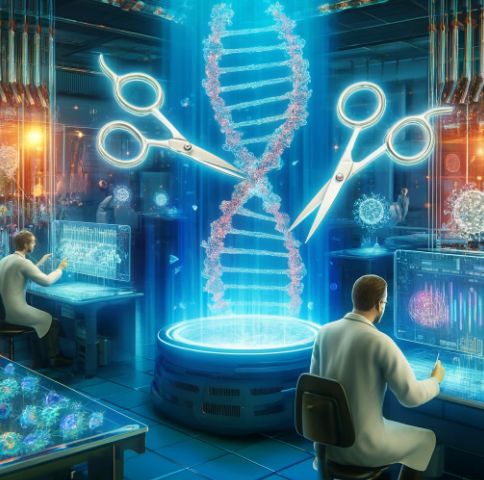Introduction
CRISPR (Clustered Regularly Interspaced Short Palindromic Repeats) technology has revolutionized the world of gene editing. Since its discovery, CRISPR has been used to edit genes with precision, offering new possibilities in drug development. By modifying specific genetic sequences, CRISPR can help correct genetic mutations, understand disease mechanisms, and develop therapies that target the root cause of various genetic disorders. This breakthrough technology holds promise in areas such as cancer treatment, genetic diseases, and infectious diseases, ushering in a new era of precision medicine.
Body
1. What is CRISPR and How Does It Work?
CRISPR is a gene-editing tool that enables scientists to modify DNA sequences in a highly precise manner. It works by using a protein, most commonly Cas9, which acts as molecular scissors, cutting the DNA at a specific location guided by an RNA sequence. This targeted cutting allows researchers to either remove, add, or replace genetic material, making CRISPR a powerful tool for gene modification.
A. CRISPR vs. Traditional Gene Editing
Traditional gene-editing techniques often lacked precision and had high off-target effects. CRISPR, on the other hand, is much more accurate and cost-effective. It allows scientists to make changes to specific parts of the genome, reducing the likelihood of unintended mutations. This precision is essential in drug development, where altering the wrong gene could have detrimental effects.
B. CRISPR and Gene Therapies
CRISPR is being used to develop gene therapies that can correct genetic mutations. For example, sickle cell anemia, caused by a single gene mutation, has been a target for CRISPR-based therapies. By editing the defective gene in stem cells and reinserting them into the patient, scientists can potentially cure the disease. This approach is being explored for many genetic disorders, including cystic fibrosis, Duchenne muscular dystrophy, and Huntington’s disease.
2. CRISPR’s Impact on Drug Development
A. Accelerating Drug Discovery
CRISPR allows researchers to model diseases in the lab by editing the genes of cells or animals to mimic human diseases. These models help scientists understand the disease mechanisms at the genetic level and identify potential drug targets. By accelerating the development of accurate disease models, CRISPR shortens the drug discovery timeline, enabling faster identification of promising compounds.
B. Targeted Therapies and Personalized Medicine
CRISPR is a critical tool in developing targeted therapies. By editing the genes responsible for diseases, CRISPR can help create treatments tailored to individual patients. This precision medicine approach ensures that treatments are more effective and have fewer side effects. In oncology, for instance, CRISPR is being used to develop therapies that target cancer cells based on their unique genetic mutations.
C. Applications in Infectious Diseases
CRISPR is being used to develop treatments for infectious diseases such as HIV and hepatitis B. By targeting viral DNA, CRISPR can potentially eliminate the virus from the host cells. This approach holds promise for curing chronic viral infections that current therapies can only manage, rather than eliminate.
3. Challenges and Ethical Considerations
A. Off-Target Effects and Safety Concerns
Despite its precision, CRISPR is not without risks. Off-target effects, where CRISPR cuts unintended sections of DNA, can lead to unpredictable mutations. This presents a significant safety concern, particularly in therapeutic applications. Researchers are continuously working to improve the accuracy of CRISPR to minimize these risks.
B. Ethical Issues in Human Gene Editing
The use of CRISPR in human gene editing has sparked ethical debates, especially regarding germline editing, where changes to an embryo’s DNA can be passed on to future generations. While CRISPR offers the potential to eliminate genetic diseases, it also raises concerns about designer babies and the possibility of misuse. International guidelines and regulations are needed to ensure responsible use of CRISPR technology.
C. Regulatory Challenges
Regulating CRISPR-based therapies is another challenge. Governments and regulatory agencies are still determining the appropriate frameworks for approving gene-editing treatments. Ensuring that CRISPR therapies are safe and effective requires robust clinical trials and clear guidelines.
4. Current Applications and Success Stories
A. CRISPR in Cancer Research
CRISPR has been used in clinical trials to engineer immune cells to better fight cancer. For example, CRISPR-edited T cells are being used to target specific antigens on cancer cells, enhancing the immune system’s ability to destroy tumors. This approach, known as CRISPR-based immunotherapy, has shown promise in treating leukemia and solid tumors.
B. Gene Editing for Blood Disorders
One of the most significant successes of CRISPR has been in treating blood disorders like sickle cell anemia and beta-thalassemia. Clinical trials have demonstrated that CRISPR can edit hematopoietic stem cells, which produce red blood cells, to correct the genetic mutations responsible for these diseases. Patients receiving CRISPR-based treatments have shown long-lasting improvements, marking a significant milestone in gene therapy.
C. Agriculture and Biotechnology
Beyond human health, CRISPR is also being used in agriculture to develop crops that are more resistant to pests, diseases, and environmental stressors. This application could lead to more sustainable food production and improve global food security.
5. Future Directions of CRISPR in Drug Development
A. CRISPR and Epigenetic Modifications
While CRISPR has traditionally been used to edit DNA, recent advancements are focusing on CRISPR’s ability to modify the epigenome, which regulates gene expression without changing the underlying DNA sequence. This opens new possibilities for drug development, particularly in diseases where epigenetic changes play a key role, such as cancer and neurodegenerative disorders.
B. CRISPR in Synthetic Biology
CRISPR is also being used in synthetic biology to create organisms with entirely new functions. For example, researchers are using CRISPR to design microorganisms that can produce valuable compounds, such as biofuels or pharmaceuticals. This approach could lead to more efficient and sustainable drug production methods.
C. Gene Editing and Aging
CRISPR may one day play a role in addressing the biological processes of aging. By targeting genes involved in aging and age-related diseases, CRISPR could extend lifespan and improve health during old age. While this area of research is still in its infancy, it holds exciting potential for the future.
Conclusion
CRISPR is revolutionizing the field of drug development, offering unprecedented precision in gene editing and the potential to cure genetic diseases. While challenges remain, including safety concerns and ethical considerations, the future of CRISPR in medicine is promising. As the technology continues to evolve, it will undoubtedly play a significant role in advancing precision therapies and transforming how we approach disease treatment.
References (Books & Articles):
- Doudna, J. A., & Sternberg, S. H. (2017). A Crack in Creation: Gene Editing and the Unthinkable Power to Control Evolution. Houghton Mifflin Harcourt.
- Barrangou, R., & van der Oost, J. (2015). CRISPR-Cas Systems: RNA-Mediated Adaptive Immunity in Bacteria and Archaea. Springer.
- Ledford, H. (2015). CRISPR, the Disruptor. Nature, 522(7554), 20-24.
- Jinek, M., Chylinski, K., Fonfara, I., Hauer, M., Doudna, J. A., & Charpentier, E. (2012). A Programmable Dual-RNA–Guided DNA Endonuclease in Adaptive Bacterial Immunity. Science, 337(6096), 816-821.

